When winter rolls around, every truck owner knows the struggle—early morning starts in sub-zero temperatures, frost-bitten windshields, and numb fingers scraping at stubborn ice.
In these harsh conditions, a truck’s cold-start defroster setup can either be a loyal winter ally or a source of daily frustration. For truckers, adventurers, and working-class warriors, time is everything—waiting ten minutes for a windshield to defrost isn’t just annoying, it’s impractical.
This is where cold-start defroster systems come into play. Modern trucks come with a range of features like remote start, heated windshields, rapid-acting HVAC systems, and even heated washer jets.
But not all trucks are built equally. Some will get your view cleared in under 60 seconds; others will test your patience in ways you never imagined. For those living in cold climates, the defroster performance isn’t just a luxury—it’s a dealbreaker.
As a seasoned automobile addict who has braved icy parking lots and early-morning frost fogs for years, I’ve compiled a list of 5 trucks that get it right when it comes to cold-start defrosting—and 5 that lag so hard you’ll wish you stayed home. So buckle in, and if winter’s your battleground, you’ll want to read this through before your next truck purchase.
5 Trucks with the Best Cold-Start Defrosters
Here are five champions of winter mornings—trucks that’ll have your windshield frost-free before you even finish your coffee. From responsive HVAC controls to high-output defroster vents and remote start excellence, these trucks take the cold seriously.
Whether you’re hauling gear or heading to the job site, these models make sure your visibility is never compromised. These are the cold-weather warriors you want in your driveway when the mercury plummets below freezing.
ALSO READ: 5 Models With the Best Roadside‑Assistance Ratings and 5 With the Poorest
1. Ford F-150 (with Remote Start and Max Defrost Mode)
The Ford F-150, particularly the newer 2021+ models, boasts one of the most intuitive and efficient cold-start defroster setups in the industry. With its Max Defrost mode, the system blasts high-speed air at full temperature across both the windshield and front side windows. Pair that with optional remote start (via the FordPass app or key fob), and your F-150 will be toasty and clear before you even step outside.
The HVAC system activates instantly, and what’s brilliant is how quickly the warm air reaches optimal temperature.

Unlike some systems that lazily trickle lukewarm air, the F-150 gets aggressive, throwing heat within the first 30 seconds—seriously.
It also features heated mirrors, rear window defroster, and in higher trims, heated wiper park areas, which prevent the dreaded frozen wiper scenario. Add in Ford’s auto climate recall settings, and your truck remembers how you like it, even after a full shutdown.
In cold-start testing, owners have reported clear front visibility in under 2 minutes, even in -15°C temperatures. That’s phenomenal. If you’re in Minnesota, Montana, or even the snowy peaks of Colorado, the F-150 is built to conquer the frost, not surrender to it.
2. Chevrolet Silverado 1500 (Equipped with Auto-Start and Heated Package)
Chevy’s Silverado 1500 isn’t just brawn—it’s surprisingly brainy when it comes to cold-weather capability. Opt for the Cold Weather Package, and you’ll unlock a powerhouse defroster setup that’s more thoughtful than most luxury sedans.
The automatic climate control system syncs immediately with the remote start function, and instead of a gradual ramp-up, you’re hit with max airflow within seconds. On colder days, it preconditions both cabin and windshield surfaces using data from external temperature sensors.

The standout feature is the heated front windshield zone, paired with quick-acting side mirror defrosters and wiper de-icers—yes, heated strips underneath the wiper blades to keep them pliable and ice-free.
Chevy also uses a dual-zone climate system, and unlike many setups, defrost functions don’t require fiddling through layers of menus. A dedicated ‘defrost-only’ button activates the system immediately, with air diverted to both upper and lower vents. That means no waiting around wondering if it’s actually working.
Owners in regions like Northern Michigan swear by the Silverado’s ability to melt off thick frost within 90-120 seconds. If you’re the kind of person who doesn’t tolerate windshield fog or morning delays, this is your ice-busting workhorse.
3. Ram 1500 (With Active Air Dam and Engine Warm-Up Strategy)
The Ram 1500 has a clever approach to cold-start efficiency. Ram’s engineers didn’t just toss in a defroster—they engineered the entire powertrain and HVAC strategy around cold-weather startup. With features like an active front air dam and thermal management systems, the Ram warms up its engine and cabin faster than you’d expect from a full-size truck.
Engage the remote start, and the system preheats the coolant circuit while enabling high-speed airflow through the defroster vents.

The automatic climate control system knows when to direct warm air to the windshield versus the footwells or rear cabin, and the heat comes on strong, sometimes startlingly so.
The defrost vents are wide and angled well, blasting the entire windshield area rather than narrowly focused jets. Pair that with heated side mirrors, an available heated windshield wiper park, and quick-heating seats, and you’re looking at a cozy cold-start environment.
What makes Ram stand out is how quickly you get functional visibility, within 2 minutes. Most drivers report full windshield clarity by the time the vehicle has even finished its remote start cycle. Combine that with FCA’s intuitive Uconnect system, and you’re driving smarter, warmer, and safer.
4. Toyota Tundra (2022+ Models with Climate Intelligence)
Toyota might be known for reliability, but the 2022+ Tundra proves they’ve taken winter drivability seriously. Their defroster setup, aided by Toyota’s Smart Climate Management System, is smooth, responsive, and effective. The new platform’s HVAC system is significantly faster than older models—and that’s a relief.
Cold mornings are no match for the auto defog sensor, which adjusts humidity levels and internal airflow in real-time. The defrost button is conveniently placed, and its activation instantly redirects hot airflow at full blower strength to the windshield and front windows.

Remote start from the Toyota app triggers not just the engine but also climate conditioning. That includes rear window defrost, heated mirrors, and steering wheel heating, too. The best part? The system doesn’t “wait” for you to get in—it begins working within seconds of remote start.
The Tundra also comes with thermal glass on higher trims, allowing the windshield to retain heat longer, reducing re-frosting when driving through snow flurries. Drivers in upstate New York and northern Canada have consistently rated the Tundra’s cold-start defroster performance above average.
So if you want Japanese dependability fused with winter-ready utility, the Tundra’s got you—and your windshield—covered.
5. GMC Sierra 1500 (High Country with Premium Climate Controls)
The GMC Sierra 1500, especially in its High Country or AT4 trims, offers a cold-start defroster system that’s deeply satisfying for anyone facing Arctic mornings. It shares the same architecture as the Silverado but adds some premium nuances.
The climate control logic is more refined, with multi-stage warm-up protocols that prioritize windshield and mirror clearing. The defroster kicks in fast and hard, offering uniform windshield coverage with no cold spots, even on frosty mornings.

Key highlights include the heated windshield washer jets, which come in handy when de-icing with fluid. The rear defroster and heated mirrors come standard, but the Sierra adds a humidity sensor that prevents internal fog buildup—something few trucks do well.
Remote start via the myGMC app also lets you pre-schedule cold starts, so the cabin and windshield are ready before you even grab your keys. Owners report full windshield clarity in just about 1.5 to 2 minutes, depending on outside temperatures.
Bottom line: the Sierra isn’t just about luxury—it’s a winter-performance machine. If you want a truck that looks classy, works hard, and clears frost like a flamethrower, this is the one.
5 Trucks That Take Ages to Defrost
While some trucks shine in frosty conditions, others barely cut. These models struggle with slow warm-ups, underpowered defrost settings, or just poorly directed airflow. In real-world conditions, these delays can cost time and create safety risks due to poor visibility.
Whether it’s laggy systems or simply inefficient designs, these five trucks tend to test your patience rather than tackle the cold. Avoid them if fast starts and ice-free glass are must-haves in your winter routine.
ALSO READ: 5 SUVs Forgiving of Low-Grade Fuel and 5 Pinging on 87 Octane
1. Nissan Titan
While the Nissan Titan delivers solid V8 performance, its cold-start defrost system is sorely outdated. Owners from northern states and Canada routinely complain about slow cabin warm-up and underwhelming air pressure from the defroster vents.
There’s no heated windshield or fancy HVAC wizardry here. The climate controls feel analog, and even when cranked to max heat, the Titan takes over 5-6 minutes to fully clear a frosted windshield. That’s a lifetime when you’re running late.

Remote start is available, but it doesn’t engage the HVAC system consistently, meaning you often return to a cold truck that’s just been idling. The vents are oddly narrow, which causes poor defrost distribution. Worse yet, there’s no heated wiper area, so you’re dealing with frozen blades and streaked vision.
If you’re frequently facing sub-zero mornings, the Titan will have you scraping windows manually, even after starting the engine 10 minutes prior. For a truck in this price bracket, that’s unacceptable.
The Titan might haul like a champ, but in terms of defrost response, it’s still stuck in the last decade.
2. Toyota Tacoma
The Toyota Tacoma has a cult following, and for good reason—it’s reliable, off-road capable, and rugged. But when it comes to cold-start defrosting, especially in the pre-2024 models, the Tacoma feels like it’s wearing mittens in a snowstorm.
First off, the defroster is noticeably slow to warm up, even after the engine reaches operating temperature. Owners in cold-weather regions like Colorado and Alberta have expressed frustration with the weak air pressure from defrost vents and how long it takes to melt frost, sometimes up to 7 minutes for full windshield clearance.

The blower motor doesn’t seem to prioritize defrost even when set to max, and there’s no dual-zone climate control or heated windshield options on most trims. Even the remote start feature (when available) often fails to trigger the climate control system, which leaves you with a running engine and no real progress on frost elimination.
Tacoma’s HVAC layout also doesn’t optimize airflow—many users note that the side windows and corners of the windshield remain fogged far longer than the central zone. Combine that with no heated wiper zone, and you’ve got a winter visibility problem.
While the Tacoma may conquer trails, in the realm of cold-start visibility, it drags its boots painfully slow.
3. Jeep Gladiator
You’d expect the Jeep Gladiator, with its rugged image and off-road capability, to be a winter warrior too, but its cold-start defroster system is surprisingly unimpressive. Despite sharing its HVAC DNA with the Wrangler, the Gladiator’s system struggles to effectively and quickly tackle cold-weather frost.
The main issue? The underpowered defrost vent design. The airflow is weak and inconsistent, often taking 5–7 minutes to clear even a moderate layer of frost. While remote start is available, it doesn’t always engage the defroster properly, so you’re left hoping the HVAC remembers your last setting. Spoiler alert: it usually doesn’t.

Another pain point is the lack of a heated windshield or heated wiper park—both standard on rivals at similar prices. The side mirrors are heated, which helps with blind spots, but the main visibility issue—the windshield—remains a problem.
Owners in the Midwest often gripe about having to manually scrape even after remote starting the truck. And since the Gladiator has a nearly vertical windshield, frost builds up more stubbornly and takes longer to melt compared to sloped alternatives.
As much as I admire the Gladiator’s spirit, its cold-start defroster setup simply doesn’t match the rest of its rugged persona.
4. Honda Ridgeline
The Honda Ridgeline is one of the most comfortable, car-like trucks on the market. But when it comes to defrosting performance, it fails to match its SUV-level comfort with equally responsive winter features.
The Ridgeline’s defroster system is sluggish to engage and lacks the aggressive output that other trucks boast. It does come with dual-zone automatic climate control, but in practice, the air distribution to the windshield is weak and delayed. Even on max settings, it takes around 6 minutes or more for the windshield to fully clear on a freezing morning.

Remote start exists through HondaLink, but many users complain that climate memory isn’t reliable, and it doesn’t always begin defrosting immediately. There’s also no heated wiper park, which often leads to frozen blades dragging across the glass—dangerous and frustrating.
Also worth noting: the defrost vent positioning seems oddly optimized more for comfort than function. The blower doesn’t direct heat evenly across the windshield, often leaving the edges foggy for several minutes longer.
The Ridgeline may be a dream for urban comfort and on-road handling, but when it comes to snow-scraping mornings, it turns into a bit of a nightmare.
5. Chevrolet Colorado (Pre-2023 Models)
While the 2023+ Chevy Colorado has made strides in technology and comfort, older versions—particularly from 2016 to 2022—struggle with cold-start defrosting. The primary culprit? Inefficient blower power and slow-to-heat HVAC systems.
The Colorado’s cabin takes a while to warm up, and that sluggishness extends to the defroster. Many owners report needing 7 to 8 minutes before the windshield is clear enough to drive comfortably in cold climates. That’s a significant delay for anyone with a tight schedule or frozen fingertips.

The defrost airflow feels anemic, even at full blast. It’s like the system is trying to be quiet and ends up being ineffective. Worse, older Colorados often suffer from blowers that delay startup after ignition, further pushing back defrost progress.
No heated windshield, no wiper defrosters, and the remote start system (if equipped) rarely triggers the defroster setting unless you’ve manually pre-set it. Side mirrors might be heated, but that does little for your forward visibility.
If you’re shopping used and live somewhere cold, skip the older Colorado unless you plan on wearing gloves and scraping ice the old-fashioned way. The new version may be a different story, but its predecessors are glacial in more ways than one.
Winter’s no joke when it comes to vehicle performance, and a cold-start defroster isn’t just about comfort—it’s about safety, efficiency, and sanity. Whether you’re a contractor racing to a job site or a parent dropping kids off at school, waiting 5 to 8 minutes for frost to clear isn’t practical—or pleasant.
That’s why the difference between a responsive, well-engineered defrost system and a sluggish one can mean the world when choosing your next truck. The Ford F-150, Silverado, Ram 1500, Tundra, and Sierra 1500 lead the charge with aggressive airflow, smart remote-start sync, and thoughtful features like heated wipers and auto climate recall.
On the flip side, models like the Nissan Titan, Tacoma, Gladiator, Ridgeline, and older Colorado versions lag behind with underpowered systems and weak airflow. They may have strengths in other areas, but in the fight against frost, they come up short.
So if you live in a cold climate or value visibility as much as traction, don’t just test-drive in the sun—test-start at dawn. A clear windshield can define how your entire winter day begins. Choose wisely—and drive warmly.

